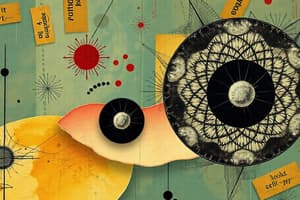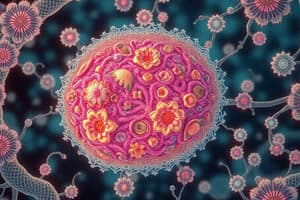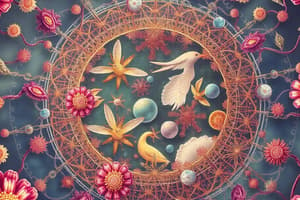Podcast
Questions and Answers
What are the primary components of lipids?
What are the primary components of lipids?
- Carbon, oxygen, and nitrogen
- Glucose and fructose
- Amino acids and fatty acids
- Carbon and hydrogen (correct)
Which of the following best describes the role of proteins?
Which of the following best describes the role of proteins?
- Transmitting signals in the nervous system
- Providing structural support and catalyzing reactions (correct)
- Energy storage and insulation
- Encoding genetic information
What defines a biome?
What defines a biome?
- A group of organisms of the same species
- The various roles organisms play in an ecosystem
- An intricate network of food chains
- A large area with specific climate and vegetation (correct)
Which of the following statements about genetic mutations is true?
Which of the following statements about genetic mutations is true?
What is biodiversity?
What is biodiversity?
What is the primary function of mitochondria in eukaryotic cells?
What is the primary function of mitochondria in eukaryotic cells?
Which cellular process involves the breakdown of glucose to release energy?
Which cellular process involves the breakdown of glucose to release energy?
What structure in the cell is primarily responsible for regulating what enters and exits the cell?
What structure in the cell is primarily responsible for regulating what enters and exits the cell?
During which cellular process does DNA information get converted into RNA?
During which cellular process does DNA information get converted into RNA?
Which organelle is involved in modifying, sorting, and packaging proteins for secretion?
Which organelle is involved in modifying, sorting, and packaging proteins for secretion?
What is the primary role of ribosomes within a cell?
What is the primary role of ribosomes within a cell?
Which process leads to the formation of four genetically unique daughter cells?
Which process leads to the formation of four genetically unique daughter cells?
What is the main purpose of lysosomes in a cell?
What is the main purpose of lysosomes in a cell?
Flashcards
Lipids' main role
Lipids' main role
Lipids primarily store energy, insulate, and form cell membranes.
Protein function
Protein function
Proteins do many jobs, like building, speeding up reactions, and moving things around.
Ecosystem components
Ecosystem components
Ecosystems have living parts (biotic) and non-living parts (abiotic) that interact.
Food web function
Food web function
Signup and view all the flashcards
Gene definition
Gene definition
Signup and view all the flashcards
Basic unit of life
Basic unit of life
Signup and view all the flashcards
Eukaryotic cell
Eukaryotic cell
Signup and view all the flashcards
Prokaryotic cell
Prokaryotic cell
Signup and view all the flashcards
Cellular respiration
Cellular respiration
Signup and view all the flashcards
Photosynthesis
Photosynthesis
Signup and view all the flashcards
DNA Replication
DNA Replication
Signup and view all the flashcards
Cell Division (Mitosis)
Cell Division (Mitosis)
Signup and view all the flashcards
Cell Division (Meiosis)
Cell Division (Meiosis)
Signup and view all the flashcards
Study Notes
Cell Structure and Function
- Cells are the basic units of life, exhibiting a wide range of shapes and sizes, adapted to specific functions.
- All cells share fundamental characteristics: a plasma membrane, cytoplasm, and DNA.
- Prokaryotic cells (bacteria and archaea) lack membrane-bound organelles, while eukaryotic cells (plants, animals, fungi, protists) have them.
- The plasma membrane regulates the passage of substances into and out of the cell.
- Cytoplasm is the jelly-like substance within the cell, containing various organelles.
- Nucleus houses the cell's genetic material (DNA), crucial for cell function and reproduction.
- Mitochondria are the powerhouses of the cell, generating energy via cellular respiration.
- Endoplasmic reticulum (ER) is a network of membranes, involved in protein and lipid synthesis.
- Ribosomes synthesize proteins based on genetic instructions.
- Golgi apparatus modifies, sorts, and packages proteins for secretion.
- Lysosomes contain digestive enzymes, breaking down waste materials and cellular debris.
- Vacuoles store water, nutrients, and waste products, particularly prominent in plant cells.
- Chloroplasts, found in plant cells, perform photosynthesis to convert light energy into chemical energy.
- Cytoskeleton provides structural support and facilitates cell movement, composed of microtubules, microfilaments, and intermediate filaments.
Cell Processes
- Cellular respiration is a metabolic process that breaks down glucose to release energy in the form of ATP.
- Photosynthesis converts light energy into chemical energy in the form of glucose.
- DNA replication is the process of duplicating DNA molecules before cell division.
- Transcription converts DNA information into RNA.
- Translation uses the RNA information to build proteins.
- Cell division, including mitosis and meiosis, is vital for growth, repair, and reproduction.
- Mitosis produces two identical daughter cells.
- Meiosis produces four genetically unique daughter cells for sexual reproduction.
- Cell signaling is a communication process between cells using chemical signals.
- Apoptosis is programmed cell death, a natural process vital for development and homeostasis.
- Enzymes are biological catalysts that accelerate biochemical reactions.
Biological Molecules
- Carbohydrates are organic molecules composed of carbon, hydrogen, and oxygen, serving as energy sources and structural components.
- Lipids are diverse organic molecules composed of primarily carbon and hydrogen, playing critical roles in energy storage, insulation, and membrane structure.
- Proteins are complex molecules composed of amino acids, performing a wide variety of functions, including structural support, catalysis, and transport.
- Nucleic acids (DNA and RNA) store and transmit genetic information.
- Water is essential for life, regulating temperature, acting as a solvent, and participating in many biochemical reactions.
Ecology
- Ecology studies the relationships between organisms and their environment.
- Ecosystems consist of biotic (living) and abiotic (non-living) components interacting.
- Biomes are large regions characterized by specific climate, vegetation, and animal life.
- Food webs depict the flow of energy and nutrients through an ecosystem.
- Populations are groups of individuals of the same species in a given area.
- Communities are groups of different populations interacting in a specific habitat.
- Biodiversity refers to the variety of life on Earth, encompassing genetic, species, and ecosystem diversity.
- Human activities significantly impact ecosystems, leading to habitat loss, pollution, and climate change.
- Conservation efforts aim to protect biodiversity and ecosystem health.
Genetics
- Genetics studies inheritance and variation of traits.
- Genes are segments of DNA that code for specific proteins.
- Chromosomes are structures containing DNA organized into genes.
- Mutations are changes in DNA sequence, causing variations in traits.
- Mendelian genetics describes patterns of inheritance based on dominant and recessive alleles.
- Non-Mendelian inheritance patterns involve multiple genes or environmental factors.
- Genetic engineering allows modifying genetic material for various purposes.
- Genetic disorders result from mutations affecting gene function.
Studying That Suits You
Use AI to generate personalized quizzes and flashcards to suit your learning preferences.




